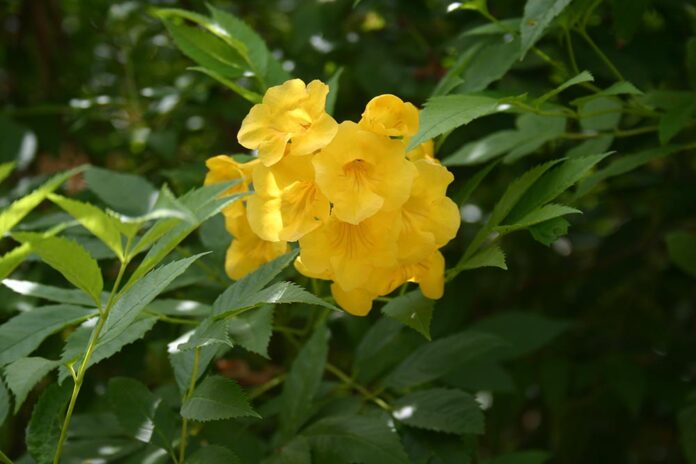The other day as I was driving along Loop 499 towards the airport, I suddenly realized that something was missing! Indeed, the beautiful Yellow Bells that had graced the median so beautifully were no longer there. In their place were sad looking mounds of turf with a few sticks raised to the sky. But I though Esperanza were perennial in our climate!
Further research told me that yes, the Esperanza was a perennial shrub in zones 9-11, but it was not frost hardy and would die back if temperatures dropped below freezing. The remedy – to cut it back to the ground and mulch it heavily – had certainly been applied, but apparently unsuccessfully. This tactic was supposed to produce new growth in the spring, but unfortunately, these Esperanza had become another victim of our February freeze, most likely because the plant had already begun to come out when the freeze arrived and continued for several days.
A short drive around town revealed the lack of bright yellow flowers in their usual locations – with the exception of the parking lot of Books and Things on North 1st Street. There the plants were noticeably smaller than they had been in the past, but still very much a presence with their beautiful flowers. Part of my surprise was undoubtedly the fact that I had moved my own Esperanza from the ground to a pot shortly after the freeze and it’s doing quite well, but realistically, my plant was on the east side of the house and had some protection unlike those Esperanza in the concrete median of the highway which were subject to the strong north winds and sustained temperatures below freezing. Similarly, the plants at Books and Things are on the south wall of the building, not out in the open.
Regardless of our losses from the February freeze, I would still recommend Esperanza because here we deal with heat more that cold. As Greg Grant, a lecturer for Stephen F. Austin University and coauthor of The Southern Heirloom Garden points out, “It’s a common horticultural misnomer to think that all plants want to grow in the cool damp climate of England (because) there are a great number of plants that don’t grow well under mild conditions.
These are the plants Texas gardeners should be growing. Instead of growing plants native to cool moist temperate areas, we should stick to plants native to Texas, Mexico, and Tropical America…Within those Texas tough plants, there’s an even fiercer group…plants that don’t even THINK about performing until they see others cooking. “ (aggie-horticulture.tamu.edu) One of the best of these heat tolerant plants for our Valley is the one known as “Esperanza,” the Spanish word for “hope.”
Esperanza is a member of the Bignoniaceae family (yep, same as the begonia), a family which contains other proven Texas performers such as Trumpet Creeper, Crossvine, Catulpa, Desert Willow, and Cape Honeysuckle, all known for big, showy flowers on rugged plants. There are numerous forms of Tecoma stans, but the biggest and showiest is the Texas Superstar known as the Gold Star Esperanza.
It’s usually a perennial here in the Valley (and as far north as San Antonio), and is basically pest-free in our landscapes. Its hardiness zone is Zone 9, exposure is full sun, and it can easily grow to 6 feet tall and 4 feet wide. The planting hole for a container grown plant should be about two to three times the size around as the root ball and just as deep as the pot it was grown in. Allow at least three to four feet between bushes. Once established, the Esperanza blooms from May until at least October and can take long periods of drought. It’s still a good idea, however, to protect moisture levels with mulch (being careful not to cover the actual trunk of the shrub).
Water and fertilize the plant with a 20-20-20 fertilizer when first planted and at the start of the growing season. If you remove the seed pods that look like string beans, you’ll have more flowers, but you can allow a few to turn brown on the plant and start new plants. The seeds should be planted two per pot and about an eighth of an inch deep, then misted with water. They should germinate in two to three weeks, but remember that they may not be identical to the original plant.
They are also easy to propagate from cuttings. In late winter remove up to half the height and cut back lateral branches to maintain the shape you want. If you prune the shrub deeply in January, you’ll have an even bushier plant in the next season, but avoid pruning in late summer or fall because the plant blooms on older growth. The flowers appeal to bees, butterflies, and hummingbirds and have a pleasing fragrance. They are lovely to look at as they bloom in clusters of yellow bells, and are a great addition to any South Texas landscape.
SOURCES:
aggie-hortiulture.tamu.edu/ornamentals/nativeshrubs/t.
plantanswers.com/arcadia_pages/plant_of_the_month
gardeningknowhow.com/ormanental/shrubs/Esperanza
homeguides.sfgate.com




